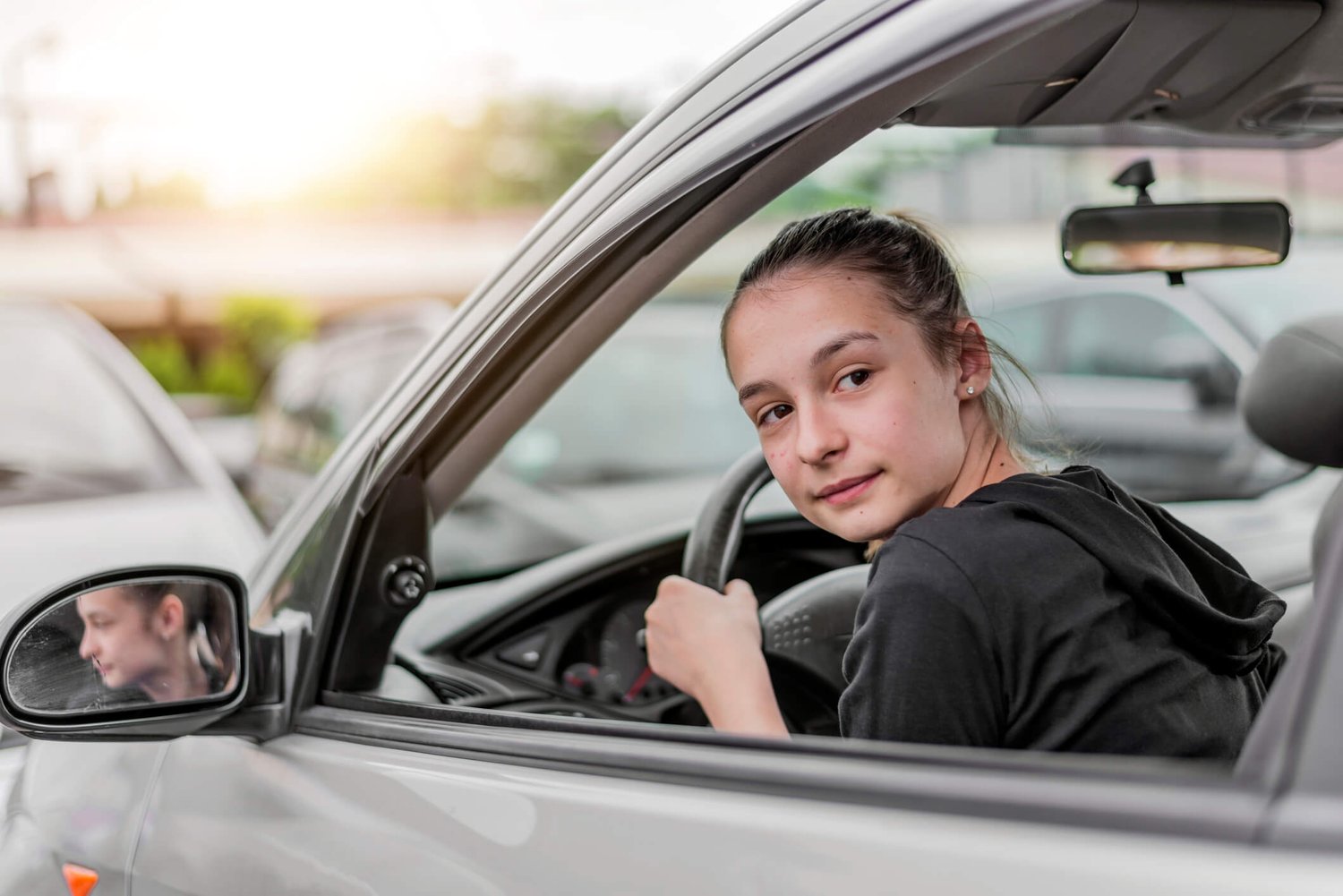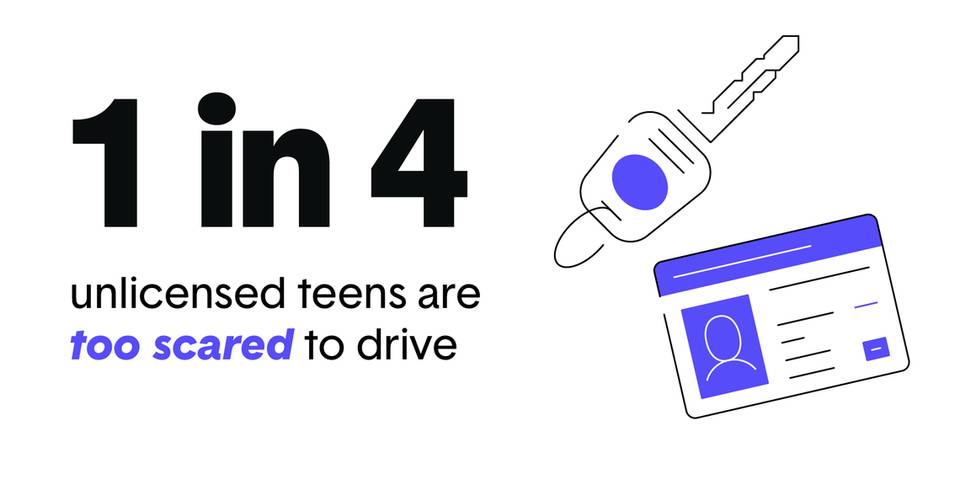A new survey by The Zebra[1] reveals which teens are most scared, parents’ fears about teen driving, and why their worries are warranted.
Study: 1 in 4 teens too scared to drive

Table of contents:
Though the road can be unpredictable, your insurance policy shouldn't be. Explore comprehensive auto insurance options.
A quarter of teenagers are hesitant to get on the road
Decades of alarming statistics and parental trepidation about the very real dangers of teen driving appear to have hit home for today’s teens. Almost 25% of non-driving teens surveyed in a new report by The Zebra say they’re not licensed because they’re scared to drive a car. We explore how parents could be influencing that sentiment, and why those concerns may be justified.
Key Findings
1. Teens say driving is scary—and it’s causing them to delay getting licensed.
2. Parents agree, and their worry may influence teens more than they realize.
3. Teens really are more at risk than other drivers on the road. Here’s why.
4. What can parents do to help their teen safely join the ranks of licensed drivers?
Key FInding 1
Teens Say Driving is Scary—and It’s Causing Them to Delay Getting Licensed
The U.S. is a nation of drivers, and many of us fondly remember how eager and excited we felt to get licensed and hit the road. Many teens today share those sentiments—but they feel something else, too.
It’s fear.
- 40.2% of teens think driving is scary
- 25.4% of adults think driving is scary
Not only were teens surveyed by The Zebra far more likely to fear driving than adult survey respondents, 23% of unlicensed teens said fear was one of the key reasons they decided not to drive.

Further, some teens are more afraid than others.
Teen girls were more likely than boys to admit that they thought driving was scary, and they were more likely to delay driving as a result of those concerns.
Teens who think driving is scary:
- Boys: 33.3%
- Girls: 46.3%
Unlicensed teens who are too scared to learn to drive:
- Boys: 16.9%
- Girls: 25.7%
Teens’ fear of driving also differed based on where they live. Teens from suburban and rural communities were less likely to find driving scary than teens who have to navigate busier urban streets.
Teens who think driving is scary:
- Urban teens: 51.4%
- Suburban teens: 35.3%
- Rural teens: 35.1%
“I don’t drive because I’m scared of it. When I do try I get anxiety.” — 18-year-old girl
Key Finding 2
Parents Are Fearful, Too, and It May Be Influencing Their Teens
The majority of parents (58%) said the idea of their teen driving frightens them.

Parents seemed to underestimate how much teens share these safety concerns.
When parents of non-driving teens were asked to identify why their teen doesn’t drive, only 12.5% of parents said it was fear. When teens answered for themselves, that number almost doubled to 23%.
This finding suggests two interesting points. First, parents may not be aware how much teens themselves are frightened of driving. Second, parents may not realize how much their own worries influence their teens’ driving concerns.
Parents weren’t equally worried for their teen drivers:
- Moms were more worried than dads:
- While 61.8% of moms were scared for their teen to drive, 52.9% of dads said they were frightened.
- Parents of daughters expressed more concern than parents of sons:
- While 60.9% of parents of a teen girl said they were scared for their teen to drive, that number dropped to 54% of parents with boys.
- Parents of girls were more likely to require their teen to have permission before driving at night, having friends in the car, or riding in a car with another teen driver. (It’s actually teen boys who are more at risk. According to the Centers for Disease Control and Prevention (CDC), boys aged 16 to 19 are twice as likely to be in a fatal crash than girls the same age.)
- Rural parents more fearful than others:
- More parents in rural communities expressed fear of their teen driving (65%) than parents who live in urban (54.5%) and suburban (56.5%) communities.
- (As previously noted above, rural teens were conversely the least afraid of driving, while urban teens were the most afraid.)
“I’m more scared of him driving than he is. I don’t want him to get his license!” — Mom of a 14-year-old boy
Key Finding 3
Teens Really Are the Most Dangerous Drivers on the Road
The fact that teens are letting safety concerns impact their decision to drive (or not) shows some consideration and awareness of the dangers that new drivers face.
Typically, it’s the other way around. Research has shown that youthful lack of judgment is what makes teens the riskiest category of drivers on the road. Let’s take a look at the numbers:
- Teen drivers (age 16-19) are nearly three times more likely to be in a fatal crash than drivers age 20 or older, according to the CDC.
- 75.8% of all teen-involved car crashes were caused by the teen driver making an error, according to a 2011 study by the National Highway Traffic Safety Administration. Of those errors, 60% involved teens failing to adequately observe their surroundings, being distracted, or driving too fast.
- Novice teen drivers have higher crash rates than novice adult drivers. In 2017, a AAA Foundation for Traffic Safety study found that new drivers age 21 and older got in more crashes than their more experienced peers, but they had a far fewer crashes compared to novice drivers aged 17-20.
These and other alarming findings over the years have prompted lawmakers in every state to adopt Graduated Drivers License (GDL) laws to make teen driving safer. The rules, which vary state to state, set training requirements for teen drivers and limit risks like night driving, using a phone or device while driving, and having other teen passengers in the car.
The first GDL laws rolled out in the mid-1990s, starting with Florida. That means the parents of today’s teens (the majority of whom are age 35-55) were among the first drivers to hit the road under these new restrictions. This may contribute to parents’ greater awareness of teen driving risks.
Key Finding 4
What Can Parents Do to Encourage Their Teens (Safely)?
How can parents help their teens stay safe while embarking on this important rite of passage?
Talk to your teen: Our survey indicated some important differences in the ways teens and parents think about driving. Teens tended to underestimate the impact of costs compared to adults, while some parents misread their teen’s fear of driving as a lack of interest. Ask your teen about their driving ambitions and concerns so you can make a driving education plan that helps both of you feel comfortable.
Enforce the rules: State laws that place limits on teen driving exist for a reason. Help keep your teen driver safe by adhering to them, and consider devising some of your own rules to limit the riskiest behavior. Less than half of parents said that their teen needed permission to have another teen passenger in the car, despite recent research that shows teen passengers increase the risk of a fatal accident 51% for teen drivers.
Choose a safe vehicle: Parents were split on whether it was better for their teen to drive a newer car with advanced safety features or an older model that’s less costly to fix and insure. Regardless of the vehicle’s age, the Insurance Institute for Highway Safety (IIHS) recommends that families choose a bigger, heavier car that’ll keep their teen safe in a crash. IIHS also says electronic stability control (which helps with steering on slippery roads) is a “must have” for new drivers.
Stay in touch and subscribe!
Get advice, insights and tips from our newsletter.


